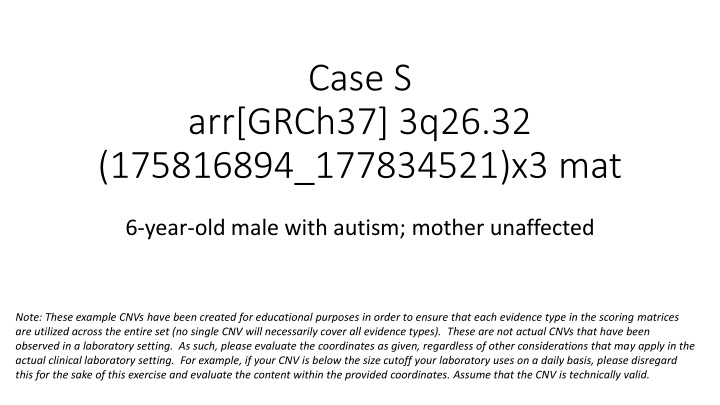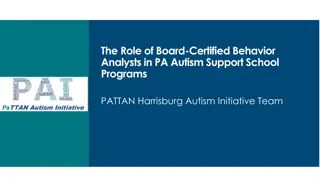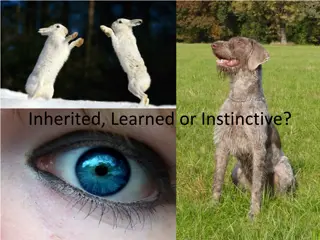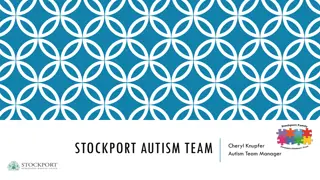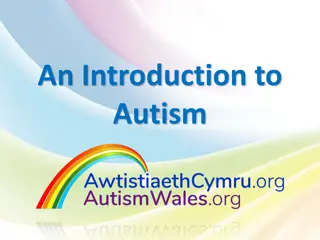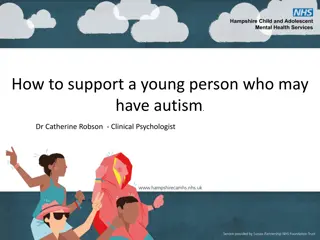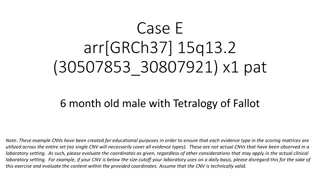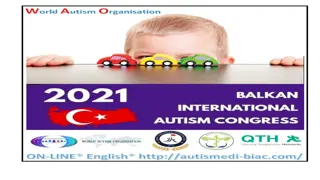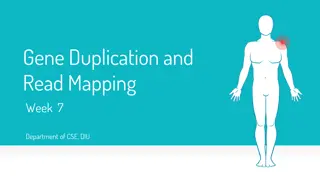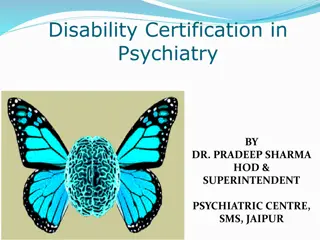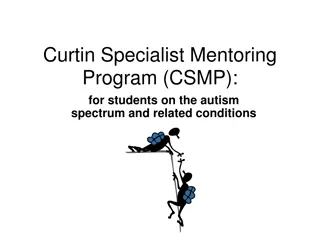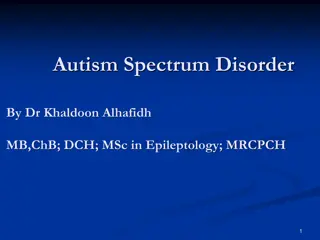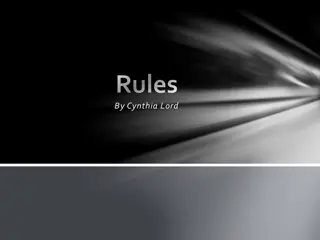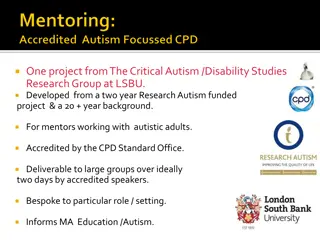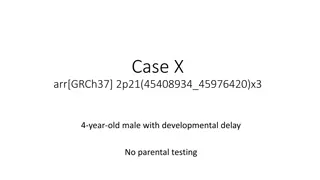Evaluation of Maternally Inherited 3q26.32 Duplication in a 6-Year-Old Male with Autism
Maternal inheritance of a 3q26.32 duplication in a 6-year-old male with autism was assessed using the GAIN scoring metric. The duplication involves the TBL1XR1 gene and was found to fully overlap with a known haploinsufficient gene. The genomic content evaluation indicates the presence of one protein-coding gene in the region. Detailed assessment of TBL1XR1 triplosensitivity score by ClinGen Dosage Sensitivity was also conducted. Relevant images and clinical information are included in the evaluation.
Download Presentation

Please find below an Image/Link to download the presentation.
The content on the website is provided AS IS for your information and personal use only. It may not be sold, licensed, or shared on other websites without obtaining consent from the author.If you encounter any issues during the download, it is possible that the publisher has removed the file from their server.
You are allowed to download the files provided on this website for personal or commercial use, subject to the condition that they are used lawfully. All files are the property of their respective owners.
The content on the website is provided AS IS for your information and personal use only. It may not be sold, licensed, or shared on other websites without obtaining consent from the author.
E N D
Presentation Transcript
Case S arr[GRCh37] 3q26.32 (175816894_177834521)x3 mat 6-year-old male with autism; mother unaffected Note: These example CNVs have been created for educational purposes in order to ensure that each evidence type in the scoring matrices are utilized across the entire set (no single CNV will necessarily cover all evidence types). These are not actual CNVs that have been observed in a laboratory setting. As such, please evaluate the coordinates as given, regardless of other considerations that may apply in the actual clinical laboratory setting. For example, if your CNV is below the size cutoff your laboratory uses on a daily basis, please disregard this for the sake of this exercise and evaluate the content within the provided coordinates. Assume that the CNV is technically valid.
Clinical Information arr[GRCh37] 3q26.32 (175816894_177834521)x3 mat 6-year-old male with autism Variant is maternally inherited Mother said to be unaffected by the ordering physician (boy s pediatrician) Use the GAIN scoring metric
Section 1: Initial Assessment of Genomic Content Case S Genes Involved Would apply category 1A (contains protein-coding or other known functionally important elements), as this duplication involves at least one protein-coding gene. 0 points; continue evaluation Total: 0 points
Section 2: Overlap with Established TS, HI, or Benign Genes/Genomic Regions Case S Established HI gene per ClinGen CNV S completely overlaps a known HI gene, TBL1XR1. Since the gene is completely contained within the duplication, we would not be concerned that the duplication would disrupt the function of this known HI gene. Use category 2H ( HI gene fully contained within observed copy number gain ). Total: 0 points
Section 3: Evaluation of Gene Number CNV S contains 1 protein-coding gene (Category 3A: 0 points). Total: 0 points
Section 4: Detailed Evaluation of Genomic Content TBL1XR1 is the only protein-coding gene in the region. Has been evaluated by ClinGen Dosage Sensitivity. What is its triplosensitivity score? Evaluate the evidence that went into this score.
Riehmer et al. 2017 (PMID:28574232) Patient 1 (Family A) Female teenager with history of autism, mild intellectual disability (ID), dysmorphic features, bilateral sensorineural hearing loss (SNHL), atrial septal defect, and subvalvular aortic stenosis Duplication de novo, parental relationships confirmed (Category 4C, 0.15 points) Patients 2-4 (Family B) Mother and two children (half-siblings to one another) Child 1 (7 years): autism, low-normal IQ Child 2 (17 years): mild ID, SNHL Mother: Declined detailed neurocognitive assessment; left school at age 12 ; no signs of autism spectrum disorder Unclear if the mother is affected or unaffected; not enough segregations to score alone Total: 0.15 points
What about the DECIPHER patients? Patient 288579 Autism and global developmental delay Variant is maternally inherited, no information about mother Classified as VUS Has two other variants, one classified as VUS, one LB Smaller than CNV S, but does include TBL1XR1 Not enough information about mother to score Patient 288492 Autism and global developmental delay Inheritance unknown Classified as VUS Has two other variants, one classified as VUS, one LB Smaller than CNV S, but does include TBL1XR1 Nonspecific phenotype, inheritance unknown no score Patient 252531 Abnormality of higher mental function, talipes cavus equinovarus Variant is de novo Unclassified No other variants reported Duplication contains 8 other genes, but TBL1XR1 is the only protein-coding gene Similar in size to CNV S; phenotype vague, but could score 0.10 (4C, non-specific phenotype, de novo variant, parental relationships assumed) PMID:28574232 Total: 0.25 points
Population Data No relevant copy number gains in gnomAD SV.
Population Data A duplication involving TBL1XR1 is reported in the DGV Gold Standard Data Set click on the variant to get additional information.
Population Data Not frequent enough to warrant negative evidence. Total: 0.25 points
Section 5: Evaluation of Inheritance Pattern/Family History for Patient Being Studied Our patient is a 6-year-old male with autism. This phenotype is consistent with what has been reported, but is very non-specific. The variant is inherited from his mother, who is said to be unaffected. Does this warrant negative points? No. Neurodevelopmental disorders are known to be associated with both reduced penetrance and variable expressivity. Without a detailed neurocognitive assessment, it is very difficult to determine who is affected or unaffected within a family. Could consider awarding points for the proband through category 5G (0.10 points). Could also consider awarding 0 points because the variant is inherited from an apparently unaffected parent, but would not award negative points for this, as discussed above. As demonstrated on the next slide, the outcome remains the same either way. Total: 0.35 points
What if we are being too conservative? What if we counted every piece of evidence we had? Riehmer Family 1 de novo, parental relationships confirmed = 0.15 Riehmer Family 2 2 segregations (assuming mom is affected) + DECIPHER case 288579 (1 segregation, assuming mom is affected) + current patient (assuming mom is affected)= 4 segregations = 0.15 DECIPHER case 288492 inheritance unknown = 0 (non-specific phenotype) DECIPHER case 252531 de novo, parental relationships assumed = 0.10 Total = 0.40 Even if ALL of this was counted, we would still not have enough to get out of VUS. More cases are necessary in order to demonstrate that duplication of this gene causes a phenotype.
Conclusion Classification: Variant of Uncertain Significance While there are case reports of individuals with duplications involving TBL1XR1 and neurodevelopmental phenotypes, additional information is necessary to demonstrate that an extra copy of this gene causes those phenotypes. Consider additional testing to investigate the etiology of the patient s autism diagnosis.
